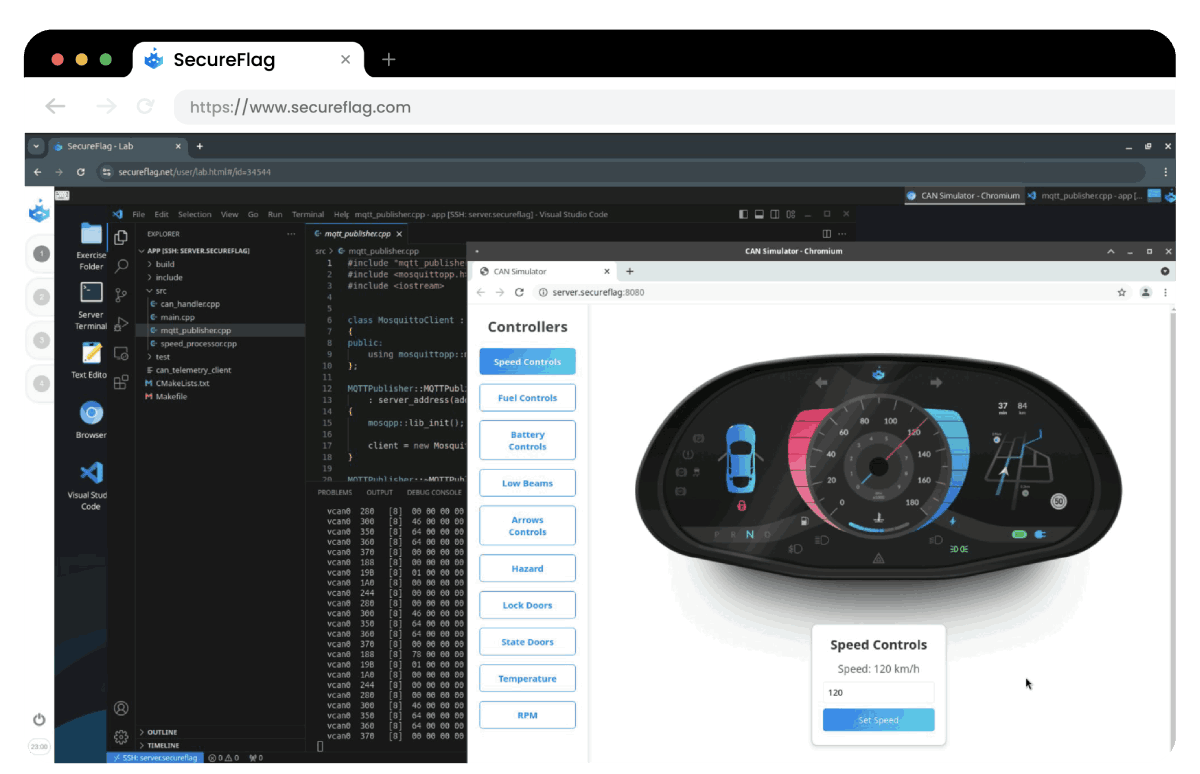Many drivers of modern cars may not be fully aware of how quickly cyber threats to the automotive industry are growing. In fact, a recent study shows that up to 60% of cyber incidents affected thousands to millions of modern vehicles last year, with large-scale attacks happening more than three times as often. Such data shows just how important it is for manufacturers to have automotive cybersecurity measures in place.
Without a doubt, the automotive industry is changing in ways we’ve never seen before. Cars are becoming more complex due to having so many connected systems. And of course, vehicles are adding more advanced features and connectivity all the time, so the risks from cyber threats are growing.

What is Automotive Cybersecurity?
These days, vehicles that are manufactured have a complicated network of electronic control units (ECUs) that manage things like engine performance and driver assistance features. These systems are always communicating internally with each other and external networks, like cloud services and other vehicles. As always, connectivity improves functionality but also creates potential security risks.
That’s where automotive cybersecurity plays a big part in protecting modern cars from these threats. When manufacturers have strong cybersecurity measures in place, it helps make sure that drivers and passengers are safe, vehicles are reliable, and even environmental protection keeps vehicle systems secure so they run efficiently.
Adapting to Emerging Cyber Threats in Vehicles
It wasn’t that long ago when vehicle security meant installing an alarm system and making sure the doors were locked, but today it’s a completely different story.
Modern vehicles are connected to the internet, receiving over-the-air (OTA) updates, communicating with other cars, and even processing cloud-based AI models for autonomous driving. While all of these advancements improve safety, efficiency, and convenience, they also introduce new cybersecurity risks.
Cybercriminals are no longer just interested in stealing cars; they are targeting in-vehicle networks, personal data, and even remote control of vehicle functions. A hacker who gets access to a car’s software could do anything, like disabling brakes and stealing driver information. Pretty scary!
This shift means that it’s necessary to have a secure-by-design approach to vehicle manufacturing, making sure that security is embedded at every stage of development and not just at the end. Also, it’s important (and mandatory) to comply with automotive regulations like ISO SAE 21434, to keep vehicles secure at all stages during their lifecycles.
Automotive Cybersecurity Threats
Cyber threats against modern vehicles are quite diverse, and many have already been seen in real-world attacks.
1. Remote Hacking of Vehicle Functions
As cars become increasingly software-driven, attackers can exploit vulnerabilities in the code. There have been cases where researchers demonstrated how they could remotely control a vehicle’s acceleration, braking, and steering, all through weaknesses in wireless communication protocols.
Vehicle-to-Everything (V2X) Exploits in Connected Vehicles
V2X technology lets vehicles communicate with components like road sensors, other cars, pedestrians, and cloud systems. Problems happen when this communication isn’t secure, as attackers could then intercept or manipulate messages, leading to misinformation about road conditions, traffic jams, or even how traffic lights are operating.
3. Keyless Entry and Relay Attacks
Many modern cars have keyless entry systems, but cybercriminals have found ways to exploit them. Relay attacks involve intercepting the signal from a key fob, which makes the vehicle think the key is nearby, and then allows thieves to unlock and drive away without ever physically handling the key.
4. Supply Chain Cyber Attacks
Vehicle components are often not created by only one company, but are developed by multiple manufacturers and software providers. A vulnerability in the supplier’s system could compromise the entire car. Attackers targeting the software supply chain could introduce malware before a vehicle even leaves the factory.
5. Data Privacy and Infotainment System Attacks
While infotainment systems are nice to use, they keep personal data, which includes things like navigation history and synced smartphone contacts. If these systems are not properly secured, attackers can steal sensitive driver and passenger information.
Emerging Technologies in Automotive Cybersecurity
As threats change, so do the security technologies made to counter them. Some of the most significant advancements include:
In-Vehicle Network (IVN) Security
As mentioned, modern cars have ECUs that communicate with each other through the Controller Area Network (CAN) bus. IVN keeps networks secure with safeguards such as intrusion detection systems, secure gateways, and authentication protocols.
Threat Modeling and AI-Driven Security for Risk Management
Proactive security measures like threat modeling and AI threat detection help catch and prevent cyberattacks before they even happen. These tools, such as SecureFlag’s ThreatCanvas, let manufacturers simulate attacks and figure out ways to defend against them, all before the car hits the road.
Encryption and Authentication Protocols
Encryption and authentication protocols make sure that data traveling between vehicle systems or to the cloud stays secure. Such measures help safeguard data so that it can’t be intercepted or altered by bad actors.
V2X Security
With cars constantly exchanging data with everything around them, keeping that communication secure is crucial to prevent cyber-physical attacks. Secure V2X frameworks ensure that only verified data gets trusted by the vehicle systems.
Cloud-Based Security Monitoring
Monitoring tools that check what’s happening in real-time help manufacturers and fleet operators keep an eye on cybersecurity events. Cloud-based platforms that track network traffic and system logs check for anything out of the ordinary. Teams can then work on potential threats before they turn into bigger problems.
Cybersecurity Framework and Best Practices
A cybersecurity framework is a set of guidelines and best practices that help organizations manage and reduce cyber risks. In the automotive industry, it plays a vital role in keeping connected vehicles and their systems safe.
A framework should include risk management, security testing, and incident response planning. Best practices involve building security into vehicles from the start, regularly testing for vulnerabilities, and ensuring that everyone involved, such as engineers and suppliers, follows cybersecurity standards.
Creating a strong cybersecurity framework means focusing on a few key areas.
-
Risk management comes first, with ongoing efforts to spot, assess, and reduce potential threats.
-
Regular security testing, like penetration tests and vulnerability assessments, helps catch and fix weaknesses before attackers can exploit them.
-
Having an incident response plan ensures that any security issues are handled quickly and effectively.
Cybersecurity Partnerships and Collaboration
The responsibility of protecting modern vehicles against cyber threats shouldn’t fall only on one team or company. Collaboration makes it easier to safeguard vehicles because everyone involved in the process, such as manufacturers, suppliers, and other stakeholders, can work together by sharing information and resources.
Teaming up with institutes like the National Institute of Standards and Technology (NIST) can provide valuable guidance, while working with cybersecurity experts and industry leaders helps identify and reduce risks. Partnerships with cybersecurity companies and research institutions also give access to the latest technologies and expertise.
With so many moving parts in the automotive world, no single company can handle cybersecurity alone. Collaboration allows organizations to share threat intelligence and develop unified strategies to address cyber risks.
Institutes like NIST provide frameworks and standards to help the industry implement strong security measures. Having a culture of teamwork lets the automotive sector strengthen its defenses and keep connected vehicles safe.
How SecureFlag is Strengthening Automotive Cybersecurity
Learning the theory about what could go wrong when it comes to protecting vehicles isn’t enough. Instead, having ongoing hands-on training provides a way for engineers and developers to practice identifying and mitigating real-world automotive threats.
Automotive Labs
SecureFlag’s automotive security training labs allow engineers and developers to gain the necessary experience to prevent cyber threats.
Our automotive cybersecurity labs cover many topics, including:
-
CAN (Controller Area Network) has been around since the 1980s, allowing ECUs to communicate without a central computer. It’s simple and reliable, but wasn’t built with security in mind, making it a target for attacks that can manipulate functions or disrupt critical systems. Our labs show how flaws in CAN could be exploited and how to secure CAN-based systems.
-
MQTT (Message Queuing Telemetry Transport): Widely used in IoT and now in cars, MQTT helps send vehicle data to the cloud for diagnostics, fleet tracking, and more. But its lightweight design often lacks encryption, leaving data vulnerable to interception. Our labs teach how to secure MQTT communications and protect sensitive information.
-
Cloud-Based Communications & Diagnostics: Cloud platforms like AWS and Google Cloud enable remote diagnostics, OTA updates, and fleet management. But with increased connectivity comes greater cyber risk, such as unauthorized access, data breaches, and man-in-the-middle attacks. The labs show how to prevent these threats so vehicles stay protected.

Automotive Risk Templates in ThreatCanvas
Threat modeling is also an important aspect when it comes to identifying threats. Our automated threat modeling solution, ThreatCanvas, now includes automotive risk templates. They help organizations comply with regulatory requirements, such as ISO/SAE 21434.
Using templates, instead of doing everything manually, makes it more straightforward for teams to find and address cybersecurity risks throughout the vehicle lifecycle. Organizations can stay compliant and improve their security posture.
Next Steps in Automotive Cybersecurity
The automotive industry is getting more and more technologically advanced, so cybersecurity shouldn’t just be a one-off challenge. Rather, it should be about keeping cars safe, secure, and ready to take on threats as they evolve. Cars are getting smarter, so security has to keep up with the changes. Here’s what needs to happen next:
-
Stronger collaboration between automotive manufacturers, software providers, and cybersecurity experts.
-
Regulatory alignment to ensure compliance with international cybersecurity standards, including automotive regulations.
-
Continuous security coding and testing throughout the development and deployment lifecycle.
-
Security-first design principles, where cybersecurity is embedded into vehicles from the beginning of the process, rather than only thought of afterwards.
Building a Safe Automotive Future With SecureFlag
At SecureFlag, we offer organizations in the automotive industry the tools they need to stay secure through practical, interactive training and threat modeling that provide guided, actionable insights. As connected vehicles become more widespread, the one thing that’s certain is that cybersecurity has to be a main priority.


